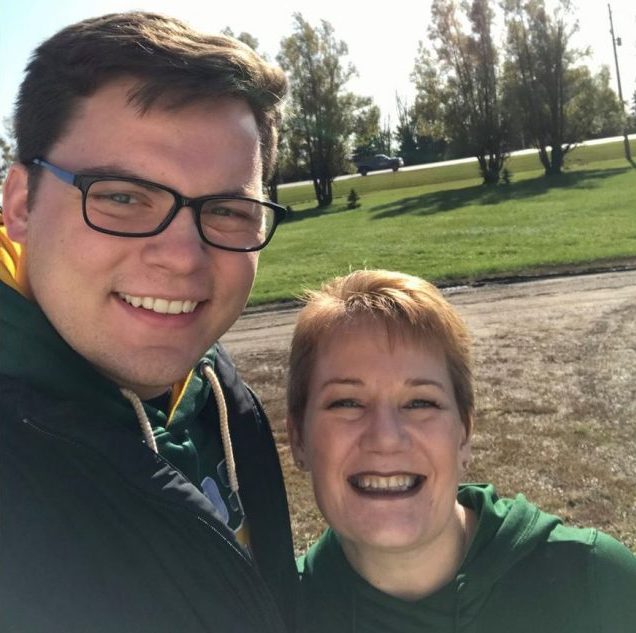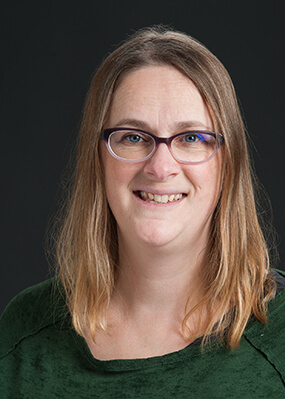Shadow a Student Challenge: Rhonda Kitch

Mindful of the Experience.
Kitch was partnered with Joe Vollmer, student body vice president. Their day began early, meeting outside Vollmer’s first class on campus. While this experience was not evaluative of the instructor, Kitch did notice the instructor made the best use possible of a classroom that was not designed for active learning.

Joe Vollmer with his shadow, Rhonda Kitch.
After class, Vollmer had a small break in his schedule, so they stopped by the student government office to check-in and take care of a few things. Kitch noted, she and Vollmer bounced back and forth between class and other responsibilities. Kitch stated, “It was amazing how many times during the day he had to shift gears in his thinking.”
Vollmer’s next class was in the A. Glenn Hill building, which also used active learning techniques. Kitch noticed this classroom was much more conducive to active learning activities. Her interest in the classrooms used stemmed from the fact that, in her role as the registrar, she was a major part of deciding the criteria for who gets their classes scheduled in the A. Glenn Hill building, a building primarily geared toward active learning. She got to see first-hand how the set up in these rooms supported the activities happening in the class and the difference it made having an appropriate space.
This experience was vastly different than the undergraduate experience she had. As an elementary education major, Kitch recalls not getting as much active learning in her classes. Though she admits, this was probably attributed more to the length of time since she was an undergraduate student than to the quality of teaching she received. As she followed Vollmer through his day, she was mindful that there were very distinct differences between Vollmer’s experience and hers, simply because of the gap in time.
Paying Attention to Details
One major thing she noticed was how small the desk space was in some classrooms, and as a result Vollmer had to strategically manage his laptop and his notebook on the tiny surface. He clearly had a strategy for what he typed and what he wrote in a notebook. That was not the only detail she noticed; he also had to determine where to sit so he could plug in his laptop. In these classes, she noticed there was a lot of juggling for both the students, as well as the instructors. “Nowadays, students appear to have amazing time management skills and a level of maturity that I’m not sure I had at that age,” said Kitch.
Connected Connections
Students are more connected now than in the past. Conversations abound as to whether this is a good thing or a bad thing. Before email, connecting with an advisor or faculty member meant you had to walk to their office and sign up for a time on their door, then come back another day or time to actually meet with them. This is now a much faster and easier process with the invention of email and other technology. Yet, in some cases, this appears to have faculty and students a bit too connected, especially if they are answering emails late into the evening. (If it is 2 a.m. and you are reading this, you have our permission to stop, go to bed, and finish the post in the morning.)
"Family support is an important factor in the well-being of students.”
Of course, this means students have a lot more options to stay connected with their families these days, too. Family support is an important factor in the well-being of students. If technology can help students maintain support from their family and friends, they may be more likely to finish their degree. On the whole, Kitch believes technology, when properly managed, can connect students to the campus community in a variety of ways.
So Much Happens Here
After the A. Glenn Hill class, they went back to the student government office for a meeting with student senators. The topic of this meeting crossed over into a lot of the work Kitch does in Registration and Records, so even though she was not at work, she was still accomplishing things.
The next class was a lab experience out at the swine barns on campus. Vollmer made it very clear that Kitch would need to dress appropriately for her shadow experience because of this lab. I am not sure how many people, in general, would participate to the extent she did. She donned all the gear and followed the safety precautions expected of the students. She participated in the day’s events, which included performing an ultrasound on a pregnant sow. She was very impressed by the support from the faculty. Kitch noted this lab was eye-opening because she had no idea how much happens in just one day on campus.
After the lab, it was late afternoon, and they stopped at a campus dining center to share a meal and reflect on the day. It was pretty obvious their time in the lab left an impression on other students dining at the center that day, too, because they got a lot of looks indicating they did not smell great. As the pair discussed the day, Vollmer mentioned some students approached him, confused about why an administrator was attending class with him. Upon explanation, most students thought the Shadow a Student Challenge was pretty cool and showed that administrators are making an effort to understand the reality of being a college student.
They Are Why We Do What We Do
Kitch took a lot away from the experience. When asked what she thought is most important for university employees to remember when assisting students, her immediate response was to remember that every student has a story.
“When a student comes to you, they are asking for help, and we should treat them with respect,” Kitch stated. They are not aware you may have answered that same question 20 times already today. When working with a student, think about the obstacles they may be facing academically, emotionally, as well as meeting their basic needs. Our NDSU values should be reflected by every member of campus in how we treat our students.
"When a student comes to you, they are asking for help… They are not aware you may have answered that same question 20 times already today.”
Kitch explains, “Students do not view the campus as isolated by department, so why should we as departments isolate ourselves by assisting only in the areas we cover?” To fully help every student we interact with, we need to be aware of the services of other offices; otherwise, we run the risk of missing an opportunity to assist a student in their time of need. When we stay in our silos, we make it more difficult than it needs to be for students, and they either dropout OR graduate in spite of us.
Kitch believed, from the beginning, that this opportunity would be important to showing students we care, and we are trying to understand their experience as a college student. Throughout the day, she noticed the value this experience could have at all levels of employment on campus. She hopes this program continues and would highly, highly encourage faculty, administrators, and staff to participate. While a full day of shadowing a student feels like a lot of time to take away from your job, the impact is so powerful it is worth it. “This has been one of the most impactful experiences of my career,” said Kitch. She notes, “It is a good reminder of why we do what we do.”
If Kitch were able to participate again (she can’t because she has since left NDSU), she would be interested in following a student from a different sub-set. For example, hearing/visual/mobility impaired, food insecure, international, multi-cultural, transfer, non-traditional, or others. She encourages anyone who has the opportunity to participate to do so. This experience was so valuable that you could participate over and over again and still learn something new each time.
Kitch’s hope is that through these experiences, there will be mindful changes in the way we work with students on campus.
If you are interested in participating in a future Shadow a Student Challenge, contact Dr. Carrie Anne Platt. Also, let us know in the comments below if you have any questions for Dr. Kitch regarding her Shadow a Student Challenge experience.
Read the experiences of other participants:
- Dr. Scott Pryor, associate dean for undergraduate programs, College of Engineering.
- Dr. Tim O. Peterson, professor of management, College of Business
- Dr. Carrie Anne Platt, associate dean, College of Arts, Humanities, and Social Sciences
About the Author

Connie Jadrny, is the marketing and public relations coordinator for the North Dakota State University (NDSU) Office of Teaching and Learning.
In more than 14 years at NDSU, Jadrny has learned a lot about higher education. She curates this blog to allow all individuals to continue learning about higher education and best practices in teaching.
Let’s learn together!